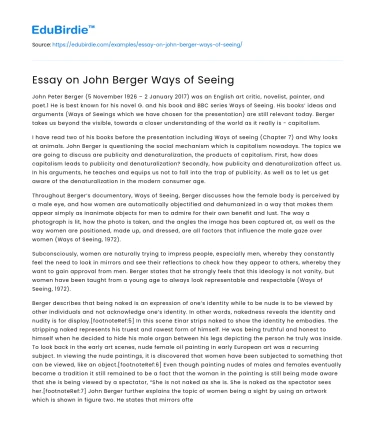John Peter Berger (5 November 1926 – 2 January 2017) was an English art critic, novelist, painter, and poet.1 He is best known for his novel G. and his book and BBC series Ways of Seeing. His books’ ideas and arguments (Ways of Seeings which we have chosen for the presentation) are still relevant today. Berger takes us beyond the visible, towards a closer understanding of the world as it really is - capitalism.
I have read two of his books before the presentation including Ways of seeing (Chapter 7) and Why looks at animals. John Berger is questioning the social mechanism which is capitalism nowadays. The topics we are going to discuss are publicity and denaturalization, the products of capitalism. First, how does capitalism leads to publicity and denaturalization? Secondly, how publicity and denaturalization affect us. In his arguments, he teaches and equips us not to fall into the trap of publicity. As well as to let us get aware of the denaturalization in the modern consumer age.
Save your time!
We can take care of your essay
- Proper editing and formatting
- Free revision, title page, and bibliography
- Flexible prices and money-back guarantee
Throughout Berger’s documentary, Ways of Seeing, Berger discusses how the female body is perceived by a male eye, and how women are automatically objectified and dehumanized in a way that makes them appear simply as inanimate objects for men to admire for their own benefit and lust. The way a photograph is lit, how the photo is taken, and the angles the image has been captured at, as well as the way women are positioned, made up, and dressed, are all factors that influence the male gaze over women (Ways of Seeing, 1972).
Subconsciously, women are naturally trying to impress people, especially men, whereby they constantly feel the need to look in mirrors and see their reflections to check how they appear to others, whereby they want to gain approval from men. Berger states that he strongly feels that this ideology is not vanity, but women have been taught from a young age to always look representable and respectable (Ways of Seeing, 1972).
Berger describes that being naked is an expression of one’s identity while to be nude is to be viewed by other individuals and not acknowledge one’s identity. In other words, nakedness reveals the identity and nudity is for display.[footnoteRef:5] In this scene Einar strips naked to show the identity he embodies. The stripping naked represents his truest and rawest form of himself. He was being truthful and honest to himself when he decided to hide his male organ between his legs depicting the person he truly was inside. To look back in the early art scenes, nude female oil painting in early European art was a recurring subject. In viewing the nude paintings, it is discovered that women have been subjected to something that can be viewed, like an object.[footnoteRef:6] Even though painting nudes of males and females eventually became a tradition it still remained to be a fact that the woman in the painting is still being made aware that she is being viewed by a spectator, “She is not naked as she is. She is naked as the spectator sees her.[footnoteRef:7] John Berger further explains the topic of women being a sight by using an artwork which is shown in figure two. He states that mirrors often represent the vanity of women, that women love the way they look that they can't help but look at themselves in the mirror, however, the intentions behind the painting were hypocritical. Instead of making the woman see her own qualities and achievements towards herself with the use of the mirror, Hans Memling uses the mirror, for his own pleasure, as a device to make the woman see herself as a sight.[footnoteRef:8] Ironically the act of looking in the mirror like Lili did does not have the same implication as for the women in the painting. In the mirror scene, Lili looks at himself in the mirror imagining himself as a woman despite the biological differences. This scene could be viewed as an act of self-acceptance that indeed he is a woman born in a man's body and that even though he was born with biologically male characteristics, he recognizes himself as a woman. She does not allow the sex she was born with to define her gender, thus showing the relationship between sex and gender.
In the last chapter of “Ways of Seeing”, he departs from his discussion of art history to deal with a strictly contemporary phenomenon: the advertisement. Even at the time of his writing nearly fifty years ago, there was already a concentration of images, such a density of visual messages around us. According to Berger, marketing images are always about the future, never about the present.2 Selling something is about creating a desire for the future. In many ways advertising doesn’t sell the product itself but envy and desire. In order to own the fantasy that the product has created, there is an exchange of money, and the exchange is the point of the image.3 Capitalism needs such constant exchanges and advertising creates the desires that fuel these exchanges is the open secret of our society.
Reference
Beger, J. (1972). ways of seeing. London:: British Broadcasting Corporation., pp.129-154.






 Stuck on your essay?
Stuck on your essay?

